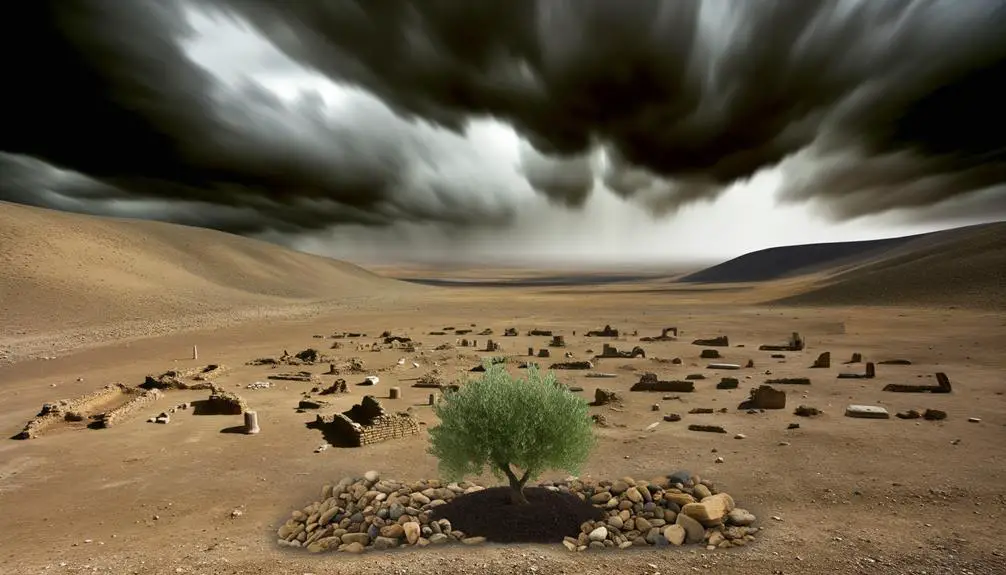The biblical concept of desolation reveals profound insights into divine judgment and redemption; discover its deeper meanings and implications.

Definition of Desolation in the Bible
In the Bible, 'desolation' originates from the Hebrew word 'shamem,' used to describe divine judgment or the aftermath of calamity. This term carries significant geographical and symbolic implications, often reflecting societal and moral decay. In prophetic books, desolation serves as a pivotal theme. For instance, Jeremiah associates it with disobedience in Jerusalem, while Isaiah and Ezekiel view it as a prelude to redemption and restoration. Symbolically, desolation transcends physical ruin, mirroring emotional and spiritual voids. It's not merely a punitive measure but a medium for divine communication, urging a deeper engagement with spiritual lessons awaiting further exploration.
Key Takeaways
- Desolation in the Bible often signifies divine judgment or the aftermath of a calamity.
- The term originates from the Hebrew word 'shamem', indicating ruin or emptiness.
- It symbolizes both physical destruction and spiritual or moral decay.
- Prophetic books like Jeremiah and Ezekiel link desolation with disobedience and purification.
- Desolation transcends physical landscapes to reflect deeper emotional and spiritual voids.
Biblical Origins of Desolation

The term 'desolation' originates from the Hebrew word 'shamem,' which denotes a state of emptiness or destruction, often used in biblical texts to describe the aftermath of divine judgment or natural calamity. You'll find this concept intriguingly woven into the historical context of ancient Near Eastern societies, where prophetic literature frequently reflects the tumultuous events of the times.
Within these texts, desolation isn't merely a spiritual or metaphorical condition; it also carries significant geographic implications. The lands described as desolate are often those which have suffered under the wrath of conquests or natural disasters, impacting their ability to sustain life and civilization. This depiction serves not only as a literal account of the physical conditions but also as a symbolic reflection of societal and moral decay.
Analyzing these instances, you can observe a pattern where desolation is often a precursor to a call for repentance or a prophetic warning of further judgment. It underscores the interconnectedness of human action and divine response as perceived in the biblical narrative. Understanding 'shamem' in its original linguistic and cultural framework allows you to appreciate its depth and complexity beyond the superficial rendering of the term in contemporary usage.
Desolation in Prophetic Books
Reflecting on the term 'shamem' in its historical context, let's explore its portrayal in the prophetic books where it serves as a powerful symbol of divine retribution and restoration. In these texts, desolation is not just a state of ruin or emptiness, but a profound commentary on the consequences of human actions and divine justice.
Prophetic imagery and apocalyptic narratives deeply intertwine within these books, presenting desolation in a multi-dimensional light. Here's how these themes manifest:
- Jeremiah: The prophet Jeremiah vividly describes Jerusalem's desolation as a direct outcome of the people's disobedience, symbolizing divine judgment.
- Isaiah: Isaiah uses desolation to forecast the eventual redemption and peace, illustrating a cycle of judgment followed by renewal.
- Ezekiel: Here, desolation is portrayed as purification, a necessary precursor to the restoration of Israel.
- Daniel: Incorporates visions of desolation within broader apocalyptic narratives that predict end-time events, emphasizing the transient nature of earthly kingdoms compared to divine sovereignty.
- Hosea: Through Hosea, desolation is a metaphor for spiritual abandonment, yet with a promise of eventual reconciliation and restoration.
These depictions aren't merely historical records or forewarnings; they are a complex layering of divine communication, intended to instruct and reform.
Symbolism of Desolation

Exploring the symbolism of desolation, you'll find it's not merely a depiction of ruin but a multifaceted emblem of divine communication and human response. In biblical narratives, desolation often transcends physical barrenness to symbolize an emotional void, reflecting the profound impact of spiritual absence or disconnect. This connection between external desolation and inner emptiness invites a deeper contemplation of one's spiritual state.
The use of landscape symbolism in this particular scenario is particularly poignant. Biblical authors frequently employ desolate landscapes to mirror the spiritual barrenness of the people or to foreshadow a necessary purification process. For instance, a desolate desert can symbolize both a literal and metaphorical journey through spiritual dryness towards redemption or enlightenment.
In your exploration of these themes, consider how the imagery of a barren city or a ravaged temple might serve to communicate messages about communal faith and individual piety. The starkness of the landscape acts not just as a backdrop but as a character itself, engaging with the human elements of the narrative to reflect back their spiritual realities.
Understanding this layer of symbolism enhances your comprehension of the biblical texts, offering insights into the complex interplay between environment, emotion, and spirituality.
Desolation and Divine Judgment
Examining biblical accounts, it's evident that desolation often serves as a stern proclamation of divine judgment against collective disobedience or moral decay. This phenomenon isn't merely punitive; it underscores the severity of straying from divine commands and the inevitable repercussions of such actions. The origins of judgment, highlighted in these narratives, reflect a divine order aiming to realign wayward societies back to moral and ethical norms.
To further understand this concept, consider the following biblical manifestations of desolation as divine consequences:
- The Flood in Genesis: A response to widespread wickedness, erasing almost all life but preserving a remnant to restart humanity.
- Sodom and Gomorrah: Overthrown due to grievous sins, serving as a potent symbol of the consequences of moral bankruptcy.
- The Babylonian Exile: Israel's exile serves as divine retribution for persistent idolatry and disobedience, emphasizing judgment based on covenantal breaches.
- The Desolation of Jerusalem: Portrayed in Lamentations, this reflects the culmination of divine warnings ignored by Judah, leading to severe loss and suffering.
- The Plagues of Egypt: Targeted judgments against Pharaoh's stubbornness and Egypt's gods, demonstrating God's power and justice in liberating the Israelites.
These examples illustrate the intricate relationship between divine judgment and desolation, emphasizing a methodical dispensation of justice based on divine law.
Responses to Desolation

Throughout history, varied responses to desolation have shaped the spiritual and communal landscapes of those affected. You'll find that emotional resilience and community support often emerge as pivotal themes in these responses. Analyzing biblical narratives, it is evident that emotional resilience isn't merely about enduring pain but also encompasses a profound transformation of personal faith and understanding.
In the face of desolation, biblical figures often exhibit a deepening of their relationship with the divine, which in turn fortifies their emotional resilience. This resilience is not an isolated phenomenon; it influences and is bolstered by the surrounding community. Community support plays an essential role, as it provides the social framework necessary for individuals to share their burdens and receive encouragement. This support system is visible in the way communities come together to pray, offer material aid, and provide emotional comfort.
These responses are methodically woven into the fabric of communal life, indicating that the impact of desolation is as much a collective experience as it is a personal journey. Therefore, your understanding of desolation should not be confined to individual suffering but should also consider the communal dynamics that are integral to coping with and eventually overcoming such profound challenges.
Restoration From Desolation
As you explore the theme of 'Restoration from Desolation' within the biblical context, it's important to ponder the promises of renewal that scripture offers. You'll find that the Bible provides numerous examples of divine restoration, which illustrate a clear pattern of recovery and rebirth. Additionally, understanding the personal rebuilding steps recommended can offer practical guidance for those seeking to overcome spiritual or physical devastation.
Biblical Promises of Renewal
In the midst of desolation, the Bible consistently offers promises of renewal, assuring you that restoration is not only possible but divinely ordained. This message of hope renewal and faith reaffirmation is integral to understanding the profound depths of Biblical teachings. The scriptures methodically outline the steps toward spiritual and physical rejuvenation, emphasizing the inevitability of divine intervention.
To paint a clearer picture:
- Hope Renewal: Scriptures instill a resilient hope for a renewed future.
- Faith Reaffirmation: Continuous encouragement to reaffirm faith amidst trials.
- Divine Assurance: Promises that God's plans are to prosper, not harm.
- Spiritual Restoration: Focus on restoring spiritual energy and connection.
- Prophetic Promises: Foretold renewals that assure a restoration of blessings.
Examples of Divine Restoration
God's narrative of restoration provides numerous examples where desolation gives way to divine renewal. Within the biblical context, the restoration of the Israelites after their Babylonian exile exemplifies hope renewal and faith reinforcement. This period of return and rebuilding isn't just a historical recount; it's a metaphorical reflection on the power of faith and the certainty of divine promises. Analyzing these events, you'll notice a pattern where profound loss and desolation are met with remarkable restorative acts by God, emphasizing the transformative potential of unwavering faith. Such narratives serve not only as historical accounts but also as doctrinal foundations that encourage believers in their moments of despair. This cyclical theme of downfall and renewal underpins the biblical assurance that restoration is always within reach.
Personal Rebuilding Steps
Journeying through the aftermath of desolation, you'll find that personal rebuilding involves strategic, reflective steps grounded in scriptural principles. This process demands a deep commitment to fostering both emotional resilience and seeking community support. Analyze your journey and align your steps with biblical teachings for a robust recovery.
- Self-reflection: Evaluate personal experiences and reactions to understand your emotional landscape.
- Scriptural meditation: Regularly engage with Bible passages that reinforce hope and perseverance.
- Community engagement: Actively seek out and participate in supportive church groups or faith-based communities.
- Goal setting: Define clear, achievable goals for personal and spiritual growth.
- Resilience practices: Develop habits that enhance your capacity to cope with future challenges, such as prayer and fellowship.
These steps are foundational in constructing a resilient, spiritually enriched path forward.
Frequently Asked Questions
How Do Modern Theologians Interpret Desolation Differently From Ancient Interpretations?
You'll find that modern theologians often interpret desolation through the lens of historical context and theological evolution, contrasting sharply with ancient views that lacked contemporary understanding of cultural and historical shifts.
Are There Any Non-Canonical Texts That Discuss Desolation?
Yes, apocryphal narratives, like the Gospel of Thomas, offer Gnostic perspectives on desolation, portraying it metaphorically as spiritual barrenness, diverging from canonical texts with their more historical or prophetic interpretations.
How Is Desolation Depicted in Contemporary Christian Art?
In contemporary Christian art, desolation is depicted through artistic symbolism and visual narratives. You'll find stark, barren landscapes and solitary figures, embodying themes of isolation and spiritual abandonment in a methodical, evocative manner.
What Are the Psychological Impacts of Desolation Themes on Believers?
You may find that desolation themes can test your faith and emotional resilience, leading to deep introspection and potentially strengthening your spiritual resolve or causing significant psychological strain, depending on your personal coping mechanisms.
How Do Different Christian Denominations Teach About Desolation?
You'll find that denominational perspectives vary on teaching about desolation. Each leans on its scriptural emphasis, analyzing texts methodically to derive meanings that resonate with their doctrinal interpretations and spiritual guidance.



Sign up